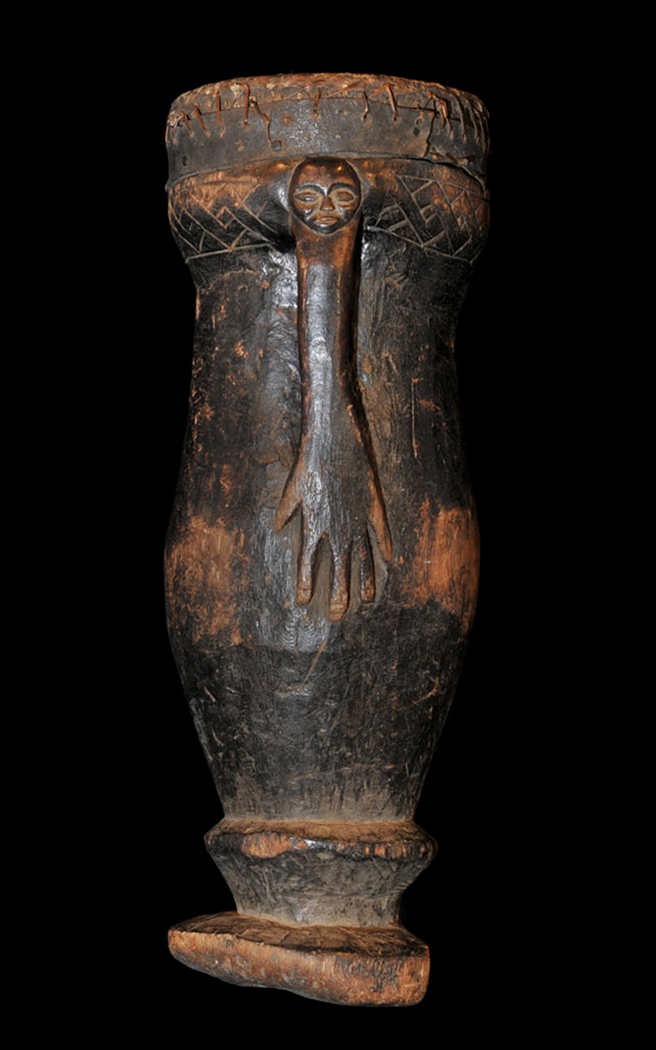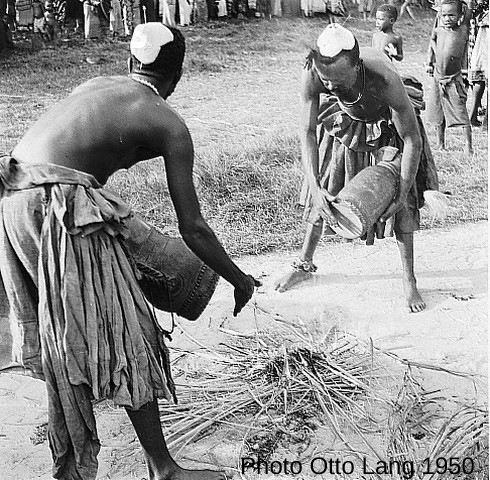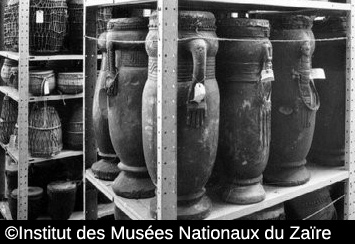DRUMS OF THE WORLD
Africa
kuba drum ngeende congo
Kuba drum ngeende Congo
„The cultures of south Zaire, east Angola and the north-west province of Zambia are mostly characterized by various influential royal dynasties. The best-known drums of the region come from the Kuba kingdom, situated between Kasai and Sankuru. Their skins are attached using a characteristc technique. A strip of leather is placed around the top of the body and nailed to it; the skin is then stitched to the leather strip.Particularly elaborate instruments have a handle on the body carved in the shape of a hand, above which is often a face. According to Olga Boone, the ornaments can be interpreted as signs of an old custom, whereby a distinguished individual could formerly only be accepted into the company of warriors on producing the hand of his slaughtered enemy (Olga Boone - Les tambours du Congo Belge et du Ruanda-Urundi 1951, p.44). Such instruments only ever belong to the king or to one of the regional chieftains."
excerpt from the book: Andreas Meyer - Afrikanische Trommeln West- und Zentralafrika, Berlin 1997 p.243
Die Trommel besitzt als Verzierung neben Kerbschnittmustern eine angeschnitzte Hand, über der sich ein Gesicht befindet. Dieser Trommeltyp gehörte zum Besitz des Königs und der regionalen Oberhäupter. Nach Boone steht die geschnitzte Hand mit einem alten Brauch in Verbindung, bei dem ein Würdenträger nur dann in die Gesellschaft der großen Krieger (Yolo) aufgenommen wurde, wenn er die Hand eines getöteten Feindes vorweisen konnte.
(Maes 1926 / Boone 1951)
References:
Boone, Olga : Les tambours du Congo Belge et du Ruanda-Urundi. 2Vol. 1951. Tervuren: Annales du Musée du Congo Belge; Ethnographie 1
Brincard, M.T. : Sounding Forms – African Musical Instruments 1989 Chauvet, Dr. Stephen. Musique Nègre. 1929
Cornet, Joseph : Art From Zaire. 1975
Dagan, Esther A. - Drums : The Heartbeat of Africa edited by Galerie Amrad 1993
Meyer, Andreas : Afrikanische Trommeln – West- und Zentralafrika. Staatliche Museen Preußischer Kulturbesitz, Berlin 1997
Wieschhoff, Heinz : Die afrikanischen Trommeln und ihre außerafrikanischen Beziehungen. Stuttgart 1933
Musical instruments of the Democratic Republic of the Congo.
Bakpekpe (Budu), Boungou (Lokele), Bugu (Zande), Chondo (Kanyoka), Condo (Luba-Kasai), Dundu (Pygmées), Ebgbge (Pygmées), Emandru (Medje),
Gbugbu (Gbandi, Mayogo), Gogo (Mamvu), Gudugudu (Ndo), Gudu-gudu (Abangba), Gugu (Zande), Igogo (Pygmées), Igogo deja (Budu), Igogo tade (Budu)
Ikokola (Boyela, Ngando), Ikokole (Batwa, Bolia, Ekonda, Twa), Ikole (Mongala), Ikookole (Mongo), Kandji (Ngoma) (Kongo), Kankonko (Sala Mpasu)
Khoko (Kongo), Kiyondo (Songye), Kyondo (Luba), Lenga (Gubu), Lokele (Bongando), Lokole (Batwa, Boyela, Ekonda, Elinga, Enga, Kutu, Mongo, Ndengese
Nkundu, Saka),Lokolé (Mongo, Mputu),Lokombe (Boyela, Ndengese, Tetela),Lokombe (Lukumbe) (Mongo),Lokuku (Ekonda),Lukumbe (Hamba, Mondja,Tetela)
Lunkufi (Songye), Magbo (Mayogo), Makpo (Budu / Mbuti), Makpo (Kpokpo) (Pygmées, Pygmées), Mandru (Mangbetu), Mgungu (Mbuti), Mokoto (Binza)
Molonge (Sengele), Mond (Lunda), Mondo (Kongo, Kwese, Mpangu, Suku, Tshokwe, Yaka), Mongungu (Ngombe), Mpopwo (Bari), Mudimba (Kanyoka, Luba)
Mungungu (Bali), Mutumba (Lunda, Sala Mpasu), Ndundu (Pygmées), Nedundu (Medje), Nekbokbo (Medje), Nekpokpo (Mangbetu), Nemandru (Mangbetu)
Nengwangu (Mayogo), Ngombi (Boa), Ngoto (Lobala), Ngufu (Yaka), Nkoko (Yaka), Nkombe (Lokombe) (Boyela), Nkonko (Kongo), Nkumvi (Luba)
N'kupila (Yaka), Shakudi (Mongo, Tetela), Tshikunvu (Lunda), Tshingoma (Kongo), Tshingufu (Chokwe, Tshokwe), Wungu (Hamba), Yeye (Mayogo)
„The cultures of south Zaire, east Angola and the north-west province of Zambia are mostly characterized by various influential royal dynasties. The best-known drums of the region come from the Kuba kingdom, situated between Kasai and Sankuru. Their skins are attached using a characteristc technique. A strip of leather is placed around the top of the body and nailed to it; the skin is then stitched to the leather strip.Particularly elaborate instruments have a handle on the body carved in the shape of a hand, above which is often a face. According to Olga Boone, the ornaments can be interpreted as signs of an old custom, whereby a distinguished individual could formerly only be accepted into the company of warriors on producing the hand of his slaughtered enemy (Olga Boone - Les tambours du Congo Belge et du Ruanda-Urundi 1951, p.44). Such instruments only ever belong to the king or to one of the regional chieftains."
excerpt from the book: Andreas Meyer - Afrikanische Trommeln West- und Zentralafrika, Berlin 1997 p.243
Die Trommel besitzt als Verzierung neben Kerbschnittmustern eine angeschnitzte Hand, über der sich ein Gesicht befindet. Dieser Trommeltyp gehörte zum Besitz des Königs und der regionalen Oberhäupter. Nach Boone steht die geschnitzte Hand mit einem alten Brauch in Verbindung, bei dem ein Würdenträger nur dann in die Gesellschaft der großen Krieger (Yolo) aufgenommen wurde, wenn er die Hand eines getöteten Feindes vorweisen konnte.
(Maes 1926 / Boone 1951)
References:
Boone, Olga : Les tambours du Congo Belge et du Ruanda-Urundi. 2Vol. 1951. Tervuren: Annales du Musée du Congo Belge; Ethnographie 1
Brincard, M.T. : Sounding Forms – African Musical Instruments 1989 Chauvet, Dr. Stephen. Musique Nègre. 1929
Cornet, Joseph : Art From Zaire. 1975
Dagan, Esther A. - Drums : The Heartbeat of Africa edited by Galerie Amrad 1993
Meyer, Andreas : Afrikanische Trommeln – West- und Zentralafrika. Staatliche Museen Preußischer Kulturbesitz, Berlin 1997
Wieschhoff, Heinz : Die afrikanischen Trommeln und ihre außerafrikanischen Beziehungen. Stuttgart 1933
Musical instruments of the Democratic Republic of the Congo.
Bakpekpe (Budu), Boungou (Lokele), Bugu (Zande), Chondo (Kanyoka), Condo (Luba-Kasai), Dundu (Pygmées), Ebgbge (Pygmées), Emandru (Medje),
Gbugbu (Gbandi, Mayogo), Gogo (Mamvu), Gudugudu (Ndo), Gudu-gudu (Abangba), Gugu (Zande), Igogo (Pygmées), Igogo deja (Budu), Igogo tade (Budu)
Ikokola (Boyela, Ngando), Ikokole (Batwa, Bolia, Ekonda, Twa), Ikole (Mongala), Ikookole (Mongo), Kandji (Ngoma) (Kongo), Kankonko (Sala Mpasu)
Khoko (Kongo), Kiyondo (Songye), Kyondo (Luba), Lenga (Gubu), Lokele (Bongando), Lokole (Batwa, Boyela, Ekonda, Elinga, Enga, Kutu, Mongo, Ndengese
Nkundu, Saka),Lokolé (Mongo, Mputu),Lokombe (Boyela, Ndengese, Tetela),Lokombe (Lukumbe) (Mongo),Lokuku (Ekonda),Lukumbe (Hamba, Mondja,Tetela)
Lunkufi (Songye), Magbo (Mayogo), Makpo (Budu / Mbuti), Makpo (Kpokpo) (Pygmées, Pygmées), Mandru (Mangbetu), Mgungu (Mbuti), Mokoto (Binza)
Molonge (Sengele), Mond (Lunda), Mondo (Kongo, Kwese, Mpangu, Suku, Tshokwe, Yaka), Mongungu (Ngombe), Mpopwo (Bari), Mudimba (Kanyoka, Luba)
Mungungu (Bali), Mutumba (Lunda, Sala Mpasu), Ndundu (Pygmées), Nedundu (Medje), Nekbokbo (Medje), Nekpokpo (Mangbetu), Nemandru (Mangbetu)
Nengwangu (Mayogo), Ngombi (Boa), Ngoto (Lobala), Ngufu (Yaka), Nkoko (Yaka), Nkombe (Lokombe) (Boyela), Nkonko (Kongo), Nkumvi (Luba)
N'kupila (Yaka), Shakudi (Mongo, Tetela), Tshikunvu (Lunda), Tshingoma (Kongo), Tshingufu (Chokwe, Tshokwe), Wungu (Hamba), Yeye (Mayogo)


